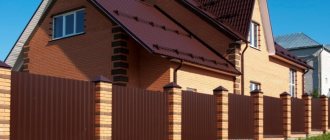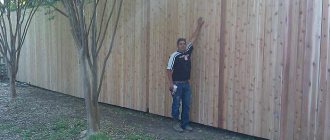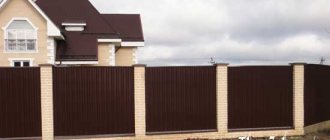It’s not for nothing that a fence made of corrugated sheets won the title of “national” - today this type of fencing can be found everywhere. But stone fences, even though they are more expensive and complex to construct, are not losing ground. Many developers dream of just such a high-strength structure and consider it both more reliable and more worthy, especially for the “front” part of the territory.
In this article we will consider the following questions:
- What nuances should you be aware of before starting construction of a stone fence?
- What foundation to choose for a stone fence.
- What construction “tricks” will allow you to save money?
- How can you decorate the structure?
Stone fence: good or not so good
Owners who decide to build a stone fence around the site or in the yard are guided by the following advantages:
- Increasing status. The aesthetics of natural material guarantees a spectacular look to the fence. The fence looks respectable, and this feeling extends to the surrounding space.
- Strength and durability. Structures made of natural stone are resistant to all types of impact, dynamic loads, and atmospheric factors (subject to proper planning and construction). Durability increases if the structure is properly maintained.
- Diversity. Different types of stones are used for masonry; it is easily combined with other building materials (wood, metal, brick). This guarantees an endless variety of designs that fit into any landscape design.
Fence and flower bed in the same style Source na-dache.pro
- Performance characteristics. A stone fence is both environmentally friendly and fireproof, which is not always the case with other options.
- Additional features. The masonry can be used as a support, for example, for a terrace or car parking.
- A decorative fence helps to zone the yard into meaningful parts (for example, it separates a recreation area).
It is impossible not to note the following disadvantages of stone construction:
- Financial expenses. Sometimes a fence can turn out to be budget-friendly if some available material (for example, cobblestones or pebbles) is found in abundance in your area. In most cases, the cost will be high, especially if you need a stone with certain decorative properties.
- The need for a quality foundation. A well-thought-out foundation makes the structure strong and durable, and it also increases the construction budget.
The foundation increases the reliability of a stone fence Source zabor.bz
What are they built from?
For construction, both natural and artificial materials are used, choosing them for financial and aesthetic reasons. The following stones are often chosen (in order of increasing cost):
- Cobblestone. A cobblestone fence is one of the most inexpensive ways to fence off an area. Cobblestone (or boulder stone) comes from high-strength rocks and has a rough, rough surface. The palette does not please with variety - gray and reddish-brown shades, which, however, easily fit into any landscape.
- Pebbles. Rounded rock fragments are found on the sea coast (beach) and along the banks of mountain rivers. Pebbles are often used for decorative purposes, as their palette is quite diverse. It is quite problematic to build a fence out of it entirely, but it can be combined with other materials (for example, brick), used to strengthen the corners of a fence or in gabion nets.
Natural stone with brick trim Source na-dache.pro
- Dolomite. A mineral with a high content of calcium and magnesium oxides, with a glassy luster that varies from matte to pearlescent. Shades – colorless, white; if there are impurities of iron or clay, then they are yellowish or brown. Dolomite is quite fragile, so a fence is not built from it, but is used in the form of slabs for cladding.
- Limestone (variety: shell rock). A common sedimentary rock, a relative of marble. It has no shine, the usual color is light gray. Impurities add variety: there are white, almost black, pinkish, light yellow and other varieties. Limestone is widely used in construction, including for the construction of fences.
- Sandstone. A homogeneous or layered sedimentary rock dominated by quartz. There is a wide variety of sandstones with different chemical compositions, some of them are used in construction as walling and facing materials. Sandstones with a siliceous and carbonate base have the best characteristics.
Fence made of limestone blocks Source wikimedia.org
- Rubble stone. Rubble is fragments of rocks (sandstone, limestone, dolomite) remaining in the field after development. The material has different sizes and weights; according to the extraction method, flagstone, bedded or torn rubble are distinguished. For laying a fence made of rubble stone, material is used in the form of a brick, for finishing - in the form of tiles.
- Artificial stone (from fiber-reinforced concrete). Successfully imitates different types of natural materials and competes with natural analogues. It is durable, lightweight, inexpensive, and is used both for cladding the entire structure and individual parts (for example, pillars). The market offers material with smooth, rough, torn texture of any color. Ultraviolet resistant pigments are used for coloring.
What does it represent?
The facing brick is called torn because one of its sides is deliberately destroyed, giving the appearance of a natural material. A wide variety of structures, shapes, sizes and shades helps it to be in demand for various tasks.
A feature of torn brick is its high weight and density (150-250 kg per square meter). A building with such cladding requires a solid foundation, and if an old building is to be reconstructed, its foundation must first be strengthened. To make the task easier, builders came up with hollow bricks, which are much lighter in weight than solid bricks and can be used in interior design.
Varieties
Solid fences made of natural stone are quite rare, mainly where it is abundant in natural conditions. Usually the fence is laid out of cut stone: cobblestone, dolomite, limestone. Granite is quite rare, due to its high cost.
Using two-color material Source stroyfora.ru
For other regions, this is an expensive pleasure, and they prefer to keep them low. Much more often, a combination of stone and other materials is used to build a fence. The following design options are common:
- Deaf (solid). Consists of stone pillars, the spans between which are filled with brick, stone, or a combination of both; Concrete panels are possible. Often they do cladding (for example, with rubble); it can be continuous or partial (along the foundation, along the pillars).
- Combined. Combinations with other materials are used; A popular option is a fence made of stone and wood. Brick may be present, often in combination with forged elements.
- Sectional. To create a fence, corrugated pipe, steel rod, corrugated sheeting, and wooden panels are used. The stone is used for cladding foundations and pillars.
- From gabions (bulk). The fence is made from a frame (welded mesh) in the form of blocks, which are filled with stones. Pebbles are best suited for the role of filler: durable, aesthetic, frost-resistant, with minimal water absorption.
Combination of wood and gabions in a modern style Source rackcdn.com
See also: Catalog of companies that specialize in the construction of fences and railings
Preparation and design
Construction of a fence made of natural stone is a multi-stage and labor-intensive process. The structure turns out to be massive, so construction requires some preparation. The work includes pouring a strip foundation, the width and depth of which depends on the characteristics of the soil and the topography of the site.
For pouring you will need reinforced concrete, which means you cannot do without a concrete mixer. Also at different stages you will need the following tools:
- Performing markings. Pegs, cord, tape measure, fittings. When marking and erecting masonry, it is convenient to use a laser level, but you can get by with a plumb line and a standard building level.
- Foundation. Shovels (scoop, bayonet), tamper, several buckets.
- Stone laying. Shovel, trowel or trowel.
Materials you will need:
- Cement (M300-400), crushed stone (20-30 mm), sand (up to 5 mm).
- Reinforcement (8-12 mm), steel pipes with a thick (at least 3 mm) wall, 3.5-4 m long.
Parameters of a stone fence with a foundation Source stroyfora.ru
- Materials for decorative finishing.
- The formwork is constructed from semi-edged boards.
The plan is carried out in relation to the area, to scale, in compliance with the dimensions of the structure. Dimensions (including the height of the fence and gate), decorations, and additional details are specified individually, based on personal preferences, style, budget and practical need. On average, the height of the enclosing structure is set within 2-2.5 m, decorative options inside the site are smaller.
Structurally, the fence consists of spans, the size of which is determined by supporting pillars. A profiled metal pipe is suitable as the basis for the supports. To fill the spans, masonry is used or sections made of another material are installed. The pipes and foundation are finished with stone.
A fence made of stone and wood on an uneven area Source na-dache.pro
How to determine the boundaries of a territory
Before you make a stone fence, be sure to find out where the boundaries of your property are. Perhaps they are not where you thought, which is fraught with the demolition of a new building, or disagreements with neighbors.
Note! In the future, it will no longer be possible to change the trajectory of the fence without its complete destruction. Invited surveyors can help you in this matter. Border delineation is one of the services they provide.
Have you already clarified the boundaries of your site? Now you can start measuring the length of the sides, as well as sketching the future structure. Do not forget to mark on your sketch the height of the fence, the places where you will have entrances (wicket, swing or other gates). The height of the fence is selected individually. If you want a high fence, then the optimal length in height is from 2 m to 2,200 cm. Next, proceed to marking the required number of pillars for support. To maintain the strength of the structure, a certain length of spans per number of supports is required: approximately 1 pillar per 2.5-3 meters of length. The maximum length of 3.2 meters is no longer recommended.
Foundation construction
For a massive, elongated structure, dense, strong soil and a low groundwater level are considered successful. In this case, a sufficient solution would be a strip shallow foundation made of monolithic reinforced concrete. If the site has complex soils, the base is selected individually; Piles may be needed. The work is performed in the following sequence:
- Site preparation. The area is cleared, plants are removed, roots are pulled out. The soil is leveled and markings are applied: pegs are driven along the contour and the cord is pulled.
- Digging a trench. The depth of the trench for a shallow foundation depends on freezing, it is 60-80 cm. The width is set depending on the width of the column, 40-50 cm. The foundation is made continuous, it should not be interrupted under the gate or wicket.
- Preparing to pour concrete. Place a sand cushion (at least 5 cm) and compact it well. Formwork is assembled from boards, which can be replaced with available materials: plywood, boards.
Fence diagram with gates and wicket Source dizainexpert.ru
- Installation of the frame. A frame of two meshes is laid at the base. The first is laid on a sand cushion, the second should be located 0.4-0.5 m below the surface. If working reinforcement with a thickness of 8-10 mm is used, then 6 mm is sufficient for transverse connections.
Reinforcement is a prerequisite for a strong foundation for a stone fence. If you neglect its parameters, the fence may crack over time. It is useful to supplement the frame with rods with a diameter of 10-12 mm or pipes of small diameter (depending on the mass of the structure).
After the frame is installed, the trench is concreted. For optimal results, it is important to choose the right, warm, but not hot season. The first day the tape is protected from rain, then from the sun and wind. Concrete reaches brand strength after 28 days, but the formwork is removed earlier, usually after two weeks. They begin to lay out rows when the foundation reaches 75% strength.
Concrete mortar in formwork Source svoizabor.com
Pros of brick
Before pouring a foundation for a brick fence, you need to understand whether it has any advantages! Or it may be worth holding off and weighing your decision more carefully. But if a person has already decided to build this particular structure, then he will definitely not go wrong with his choice.
A brick fence has a number of important advantages that distinguish it from other analogues. These include:
Reliability. A fence made from such material will serve as excellent protection from “random” guests and the glances of curious neighbors.
Long service life (minimum 10 years). If used correctly, such a fence will last a long time and will serve not only those who built it, but also their children.
Attractive view. A fence can be built not only for protection, but also to decorate the area, because a large number of different ideas can be implemented on it. For example, add small arches or weighty columns to the design.
When considering a brick fence as an investment, it is the smartest move a person can make.
Laying pillars
The fence should be as smooth as possible. To do this, it is important to carefully mark the distance between the pillars, and in the places where they are located, release the reinforcement (4 rods 12-14 mm thick). If heavy (for example, forged) gates are planned, the reinforcement is made thicker. The pillar is laid in two ways:
- Without formwork. 4 corner stones are placed on the mortar according to the markings, carefully aligning their relative positions. Then the gaps are filled, selecting stones of a suitable size, taking into account the thickness of the seams (1.5 cm). Then they fill the gaps with concrete and wait for the first row to set. The second and subsequent rows are placed with ligation of the seams (there is no seam above the seam), the process is controlled by a level.
- With formwork. To simplify the work, sliding formwork is used. It is built according to the dimensions of the pillar, which ensures its ideal dimensions. The formwork is filled with tiers of stones held together with mortar and left to gain strength. Then it is moved higher, and the space between the stones of the finished part is sealed with a cement-sand mixture.
- At the end, the foundation and pillars are faced.
The pillars are installed on the foundation first Source nikastroy.ru
Material characteristics
Rubble is fragments of irregularly shaped rocks: limestone, sandstone and dolomite. In places where this material is mined, huge blocks are divided into fragments, then sorted by size, type and technical properties. Mining waste is used to make crushed stone. Masonry stones have the following characteristics:
- strength - from M200 to M 1400;
- frost resistance - F300-F400;
- bulk density - from 1.3 to 1.9 t/m3;
- specific gravity - from 1300 to 2600 kg/m3.
The significant spread of figures for each indicator is due to culling. During mining, suitable parts of rocks are selected not by type, but by weight (30 - 50 kg) and caliber (150 - 500 mm).
An important indicator is the presence of parallel edges – beds – on the fragment. Moreover, each copy should not have internal cracks or delaminations.
Span masonry
Depending on the project, masonry is carried out or spans are installed. In the first case, before laying out a fence made of flagstone or rubble, the span sections are marked. They will be narrower than the pillars: if the width of the pillar is 40 cm, then the span is 30 cm. The wall is evenly shifted on both sides by 5 cm; in this case, the longitudinal axis of the fence remains the axis of symmetry.
The rows are laid out with bandaging along a stretched cord, starting from the outermost stones. For the final row, flat stones are selected so that the top is even. After completion of the masonry, the joints are done. At the last stage, protective caps and visors are installed (if provided for in the project).
Poles with protective caps Source expo-stolichny.rf
Finishing work
Above, we have already discussed the procedure for performing preparatory work during the construction of a fence. Speaking of the final phases, you need to cut the seams. To do this you will need a tool:
- metal brush;
- guillemot;
- suture trowel;
- sponge.
We have already discussed above how to fill seams using a bag of mortar. Jointing is done 3–4 hours after filling . Otherwise, the mass will begin to harden and the formation of joints will be problematic.
First, the surface of the stones must be cleaned with a brush to remove traces of the solution. After this, you need to form the seams using a trowel or scraper.
To give the fence its final look, it must be washed. Hard-to-remove traces of masonry mortar can be eliminated using a solution of hydrochloric acid at a concentration of about 30% and a sponge. The operation must be performed with rubber gloves. Otherwise, chemical burns cannot be avoided.
The final operation in the construction of a fence is the installation of caps on the posts and tops on the fence spans. This will prevent water from getting inside the masonry. Otherwise, when it freezes, the entire structure may be destroyed.
An excellent combined fence design solution
Briefly about the main thing
A fence made of stones is a reliable and durable fence, a beautiful detail of any landscape design. It is built from inexpensive rocks of different origins: sandstone, cobblestone, shell rock, limestone, pebbles. The design of fences is pleasantly varied, from options with solid masonry to combinations with wood and metal.
For the strength and durability of a structure, the quality of the foundation is important; it is laid taking into account natural factors and is necessarily reinforced. When the solution in the trench becomes strong, stones are laid, selecting them according to size, taking care to bandage the seams. At the final stage, the space between the pillars is filled, decorative finishing is performed, and lighting is installed.
Ratings 0











